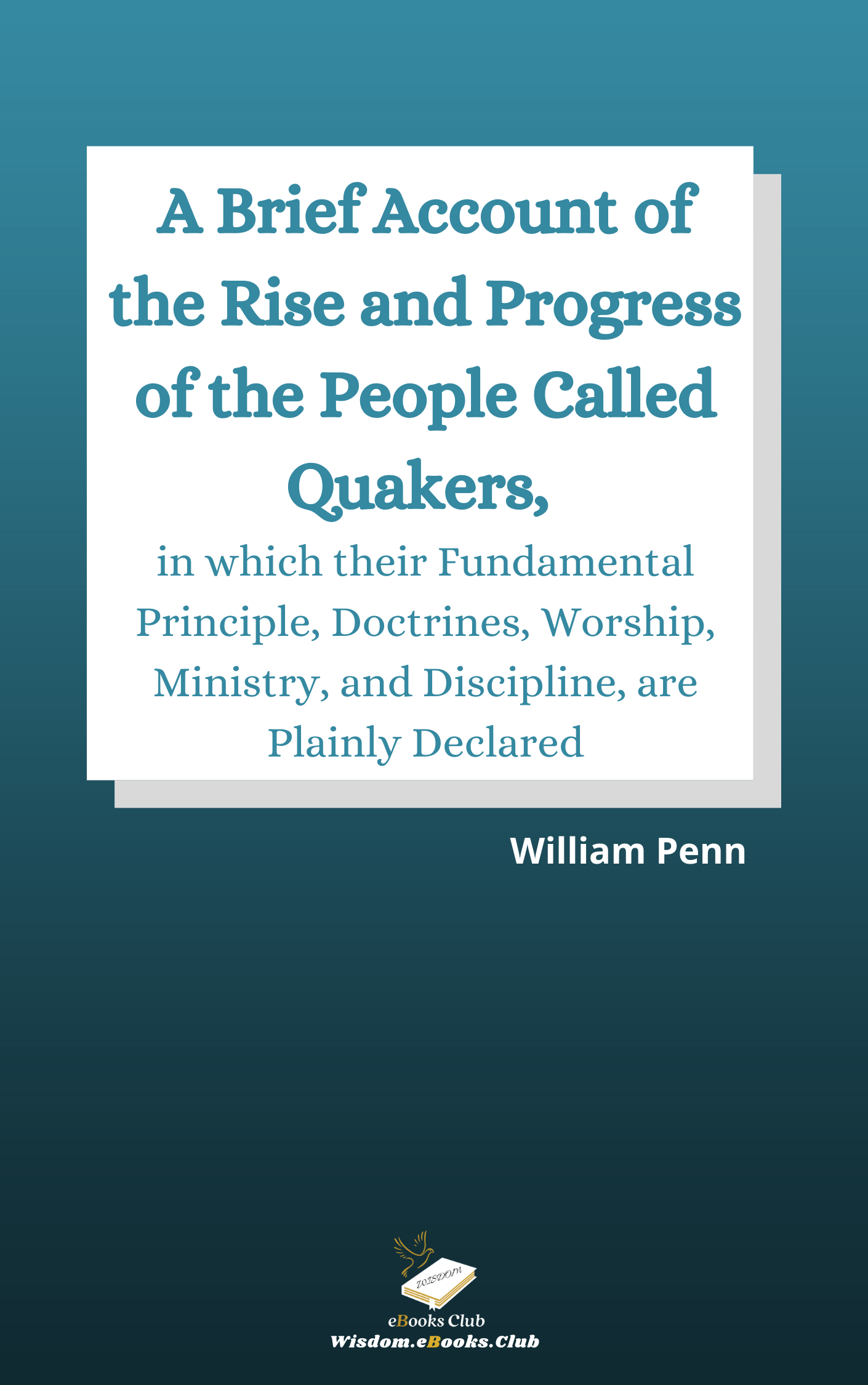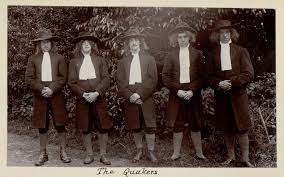A Brief Account of the Rise and Progress of the People called Quakers

Pennsylvanian Quakers
Early Pennsylvanian Quakers were recognized for their honesty in social and economic matters. Many Quakers worked in manufacturing or business, because they were not permitted to earn academic degrees. These Quaker businessmen were prosperous because people trusted them. The customers understood that Quakers had a deep conviction to set a reasonable price for goods and not to quibble over prices.
They likewise knew that Quakers were devoted to quality work, and that what they produced would be worth the cost. At the same time that Friends were becoming successful in manufacturing and business and were emigrating to different areas, they were becoming more involved in social issues and more active in society at large.
One such issue was slavery. The Germantown (Pennsylvania) Monthly Meeting published their resistance to slavery in 1688, but abolitionism did not become prevalent among Quakers until the Philadelphia Yearly Meeting reached agreement on the issue in 1754. Reaching unity was a difficult process. William Penn himself had slaves. Some Quaker businessmen had made their fortunes in Barbados or owned ships that sailed the British/West Indies/American triangle. Most Quakers didn’t oppose slave ownership when they first arrived in America.
To most Quakers, “slavery was acceptable given that slave owners attended to the spiritual and material needs of those they enslaved”. 70% of the officers of Philadelphia Yearly Meeting owned slaves in the period from 1681 to 1705; however, starting in 1688 some Quakers began to speak out against slavery. Things changed when John Woolman, a farmer, retailer, and tailor from New Jersey became convinced that slavery was unjust and published the universally read “John Woolman’s Journal”.

He wrote: “Slaves of this continent are oppressed, and their cries have reached the ears of the Most High. Such are the purity and certainty of his judgments, that he cannot be partial to our favor”. Woolman argued that not only was it unjust to abuse slaves and deny them access to spiritual learning, but that the entire system of buying, selling, and owning human beings was unacceptable in principle. Other Quakers agreed and became very active in the abolition movement.
After deciding that they would buy no slaves off the boats, they united on the issue in 1755, after which time no one could be a Quaker and own a slave. In 1790, one of the initial documents introduced by the new Congress was an appeal by the Quakers, presented through Benjamin Franklin, to eradicate slavery in the United States. By 1756 only 10% of officers of Philadelphia Yearly Meeting owned slaves.
The Southern states, however, insisted on continuing slavery. Because of this, a network of safe houses and escape routes, called the Underground Railroad, was established across the United States to bring enslaved people out of America and into Canada (British North America) or the free states. The Quakers were a prominent force in the Underground Railroad, and their efforts helped free many slaves. Immediately north of the Mason-Dixon line, the Quaker settlement of Chester County, Pennsylvania, one of the first hubs of the Underground Railroad, became the heart of the abolition movement, however, not all Quakers were of the same view point concerning the Underground Railroad: because slavery was still lawful in many states, it was therefore illegal for anyone to assist an escaped slave gain freedom. Many Quakers, who regarded slaves as equals, considered it was appropriate to help free slaves and felt it was unjust to hold someone as a slave. Other Quakers saw this as breaking the law and disturbing the peace, both of which fly against Quaker values, therefore breaking Quaker doctrine in being pacifistic. Involvement with the law and the authority was something from which the Quakers had sought to detach themselves. This controversy caused the Quakers to break off into smaller, separate branches who shared similar ideas and views.
The Quakers
Thomas Garrett, a prominent Quaker abolitionist, had an Underground Railroad stop at his residence in Delaware and was found guilty in 1848 of helping a group of slave’s escape. It was also said that Garrett worked with Harriet Tubman, a particularly well-known slave who managed to help other slaves obtain their freedom. Educator Levi Coffin and his spouse Catherine were Quakers who resided in Indiana and helped the Underground Railroad by smuggling slaves in their home for over 21 years. It is said that they helped 3,000 slaves secure their freedom. Susan B. Anthony, another well-known Quaker, did a great deal of antislavery along with her women’s rights work.
 The Quakers
The Quakers
During the 20th century, two Quakers, Herbert Hoover and Richard Nixon, both from the Western evangelical wing, were elected to serve as presidents of the United States, thus gaining higher secular political power than any Friend had retained since William Penn.
The Quakers, were called “The Religious Society of Friends”, now just “Friends”, have a curious way of conducting various portions of their church services. During these services there is no formal authority. They are required to sit in silence and wait until the spirit moves them to speak. They can observe, answer, remain silent, analyze, modify, defend, or explain. The process promotes discussion. It is the act of civil debate on matters of mutual interest. If this sounds like how democracy should work in operation, it’s because, to some measure, this is where we picked up many of our concepts of how citizens should behave.
This book embodies everything that attracts one to Quakerism from the beginning; a steadfast faith in Jesus Christ and the belief that everyone has the light of Christ in them and are of equal significance in His eyes. Sadly, these views are no longer common within the Religious Society of Friends. Quakerism has changed considerably since the 17th century. It has moved away from strong conviction in Jesus Christ into a blend of people who have a general notion of God as a ‘light’ or even dismiss God and Jesus altogether and represent themselves as pagans or atheists.
William Penn
English Quaker leader and colonist
 William Penn
William Penn
“Time is what we want most, but... what we use worst.”
-
William Penn, (born October 14, 1644, London, England—died July 30, 1718, Buckinghamshire).
-
English Quaker leader and advocate of religious freedom, who oversaw the founding of the American Commonwealth of Pennsylvania as a refuge for Quakers and other religious minorities of Europe.
-
William was the descendant of the distinguished seaman, knight and national hero Admiral Sir William Penn. Admiral Penn was affluent and occasionally lent substantial amounts of money to the crown. William received the foundations of a classical education at the Chigwell grammar school in the Essex countryside, where he fell under Puritan influences. After Admiral Penn’s naval defeat in the West Indies in 1655, the family moved back to London and later to Ireland. In Ireland William heard Thomas Loe, traveling preacher, preach to his household at his father’s invitation. In 1660 William started college at the University of Oxford, where he rejected Anglicanism and got expelled in 1662 for his theological nonconformity. Resolved to curb his son’s piety, Admiral Penn dispatched his son on tour of the European continent and to the Protestant college at Samur, in France, to finish his studies. After 2 years his father called him back to England, where William entered Lincoln’s Inn and spent a year Studying law.
-
In 1666 Admiral Penn sent William back to Ireland to govern the family estates. There he crossed paths again with Thomas Loe and, after listening to him preach, elected to join the Quakers (the Society of Friends), a faction that was deemed religious fanatics who were denounced by respectable society and subject to religious persecution.
-
William formed his new colony, Pennsylvania, to establish a sanctuary for Quakers and other religious minorities, who would be accorded freedom of worship. He described his master plan as a “Holy Experiment.” William Penn didn’t coin the name Pennsylvania. He originally wanted to call it New Wales, because of its hilly topography which reminded him of the Welsh countryside. However, a Welsh-born secretary in England’s Privy Council took issue with this, causing Penn to rethink that name. His next proposal was Sylvania, after the Latin term for forest. The Council tweaked this new name by adding the prefix “Penn” to honor William Penn’s father, the late Admiral.
-
When Pennsylvania and Maryland were initially broken up, they gave everything south of Cape Henlopen to Maryland and all that lay above the Cape was divided vertically with the eastern half going to William Penn and the western half to Maryland. However, the dispute of where the Pennsylvania-Maryland border should be remained unresolved. This matter wasn’t resolved until the 1760s, when surveyors Charles Mason and Jeremiah Dixon plotted out the most famous dividing line in America (the Mason-Dixon Line).
-
Penn’s capacity to govern his colony from overseas was weakened by three paralytic strokes he had in 1712. As his health declined, his spouse Hannah stepped up. Over the next 6 years, she managed Pennsylvania’s affairs from afar, sending instructions to governor Charles Gookin and working with James Logan, Penn’s colonial advisor. Penn passed on July 30, 1718, but Hannah continued to run Pennsylvania for another 8 years after his passing.
-
Penn spent most his time in England and passed over 50 years before the colonies proclaimed their independence. He is considered by many as one of America’s founding fathers. He received high praise from the illustrious statesmen; Thomas Jefferson, who called him “the greatest law-giver the world has ever produced. On November 28, 1984, both William and Hannah were posthumously made honorary citizens of the United States, an honor that bestowed on only 6 other persons.
To see more information about this topic or other religious topics, you may check the books and magazines available at www.wisdomebooksclub.com or visit our peals of wisdom page page by clicking on this link to access more interesting blog articles, games, quizzes, music videos, religious poems, Jewish recipes, popular sermons, and more.
